
FAST ENERGY GROWTH

U.S. EIA - Energy consumption in Asia, the Middle East, and Africa continues to grow rapidly, with about 20% growth in each region between 2010 and 2016, according to newly available data in EIA's International Energy Statistics database. In particular, energy consumption has been increasing in the Middle East and Africa, driven by economic growth, increased access to energy markets, and quickly growing populations. Energy consumption in Asia grew even as energy consumption in China declined between 2015 and 2016.
Although growth was rapid in Africa and the Middle East, Asia and Oceania consumed much more energy overall (42% of 2016 world energy consumption, compared with 6% in the Middle East and 3% in Africa). Slower long-term energy consumption trends continued in the mature economies of North America, where energy consumption grew by 1% between 2010 and 2016, and in Europe, where energy consumption actually fell 4% between those years.
Globally, petroleum and other liquid fuels (including biofuels such as ethanol and biodiesel) are the most prevalent form of energy consumed. Growing use of these fuels has been supported by increasing supplies of U.S. shale oil and other international sources of liquid fuels that have kept prices relatively competitive. Global coal consumption continued to decline as a result of competition from low cost natural gas as well as some countries' policies to limit or decrease coal use.
Regional fuel use varies according to the availability of resources. In 2016, coal accounted for almost 50% of the energy consumed in Asia and Oceania, where China, India, and Australia are all significant consumers of coal. The largest shares of nuclear and renewable energy were in Europe (26%), North America (19%), and Central and South America (26%).
These regions, particularly Europe and North America, have significant renewable resources as well as policies that encourage renewable energy usage, especially wind and solar. Because of the region's rich reserves of oil and natural gas, nearly all energy consumption in the Middle East comes from either petroleum or natural gas with virtually no contribution from coal, nuclear, or renewable energy.
From 2000 to 2013, China experienced rapid growth in energy consumption, overtaking the United States as the world's largest energy consumer in 2009. Since 2013, China has consistently used approximately 40% more energy than the United States. Although growth in China's gross domestic product (GDP) has slowed over this time period, it continues to grow faster than 6% per year compared with relatively flat total energy consumption, demonstrating the country's improvements in energy intensity (GDP per unit energy).
By comparison, India's GDP is growing at a rate of almost 8% per year, and energy use is growing as well. In recent years, India has surpassed Japan, Canada, and Germany in energy consumed. As more recent data become available, India is likely to surpass Russia as the third-highest energy consuming country.
-----
Earlier:

2018, October, 4, 15:10:00
РОССИЯ: УСТОЙЧИВОЕ РАЗВИТИЕ ЭНЕРГЕТИКИМИНЭНЕРГО РОССИИ - «Устойчивое, поступательное развитие энергетики – это ключевое условие динамичного роста глобальной экономики, улучшения качества жизни людей, повышения благосостояния всех людей на нашей планете. Россия открыта для сотрудничества в области энергетики в интересах глобальной энергетической безопасности, в интересах будущих поколений. И мы, конечно, рассчитываем на активный диалог по всем этим темам и на сотрудничество», - заключил Владимир Путин.
|

2018, September, 26, 09:35:00
OPEC: GLOBAL ENERGY DEMAND WILL UP BY 33%OPEC - Total primary energy demand is expected to increase by 91 mboe/d between 2015 and 2040 to reach 365 mboe/d in 2040
|

2018, September, 12, 12:15:00
ПЕРСПЕКТИВЫ РОССИИ В АЗИИМИНЭНЕРГО РОССИИ - «Рынок АТР будет развиваться, а экономика региона расти более высокими темпами, чем в среднем по миру. Темпы увеличения энергопотребления в два раза превысят среднемировой показатель», - спрогнозировал Александр Новак.
|

2018, August, 29, 10:50:00
РОССИЯ - ГЛОБАЛЬНЫЙ ЭНЕРГЕТИЧЕСКИЙ ЛИДЕРМИНЭНЕРГО РОССИИ - Президент добавил, что по итогам 2017 года Россия подтвердила свой статус одного из лидеров глобального энергетического рынка: «Мы заняли первое место в мире по объему добычи нефти, второе – по добыче газа. Россия входит в число ведущих стран по объему выработки электроэнергии и добыче угля: по электроэнергии – на четвертом месте, по углю – шестое место в мире». По словам Владимира Путина, в прошлом году сумма инвестиций в отрасли выросла на 10 процентов и составила 3,5 триллиона рублей.
|

2018, August, 3, 09:20:00
БРИКС: 40% МИРОВОЙ ЭНЕРГИИМИНЭНЕРГО РОССИИ - «Страны БРИКС являются одними из самых крупнейших экспортеров, производителей энергоресурсов и потребителей. На долю стран БРИКС приходится почти 40% общемирового потребления энергоресурсов», - отметил замминистра.
|

2018, July, 23, 13:25:00
GLOBAL ENERGY INVESTMENT DOWN 2%IEA - For the third consecutive year, global energy investment declined, to USD 1.8 trillion (United States dollars) in 2017 – a fall of 2% in real terms. The power generation sector accounted for most of this decline, due to fewer additions of coal, hydro and nuclear power capacity, which more than offset increased investment in solar photovoltaics.
|

2018, June, 15, 11:10:00
BP: GROWTH IN ENERGY DEMAND UPBP - In 2017 global energy demand grew by 2.2%, above its 10-year average of 1.7%. This above-trend growth was driven by stronger economic growth in the developed world and a slight slowing in the pace of improvement in energy intensity. |
















